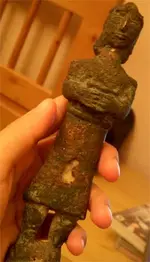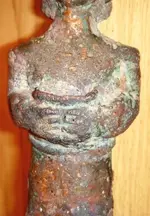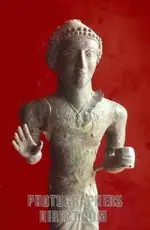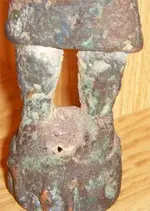Your statue looks pretty crude, where did you get it from? I think it may be a modern replica. A little info on bronze statues from Yemen-
Bronzes in Ancient South Arabia
by David Warburton
When wandering around South Arabian archaeological sites, one occasionally notes what appear to be fossil footprints, usually about the size of normal human feet, although at the ruins of the ancient Hadhrami capital at Shabwa the imprint of a single foot is more than a metre long. Needless to say, the Jurassic or Cretaceous limestone of Yemen occasionally shows marine fossils formed one or two hundred million years before the appearance of man in Yemen (or anywhere else), and therefore the footprints cannot be fossil. If you have the good fortune to wander around the storerooms of Yemeni museums, you will have the chance to see smaller fossil footprints, in smaller blocks of stone with lengthy inscriptions on one face, betraying the character of the footprints: they were cut into the rock in order to support the feet of a metal statue. The inscriptions relate that such statues were placed in front of temple facades, many of them donated by private people (including women) to the god (or goddess) of that particular temple, but also by kings. It is no surprise that only the footprint remains, as the inscriptions record that many of them were made of gold.
The statues that have been well preserved - such as those of Dhamir Alay and his son in the entry to the Sanaa National Museum - and those fragments that have been found are however made of bronze, and not gold. While it is possible that some statues were made of gold, one should not forget that ancient bronzes were not as green as we see them in museums today, but golden, at least before the acquired their patina, and the ancients were not needlessly modest when no one was contesting their claims.
Some ancient Yemeni bronze statues bear inscriptions identifying the person depicted, and thus it is clear that these are not the cult statues in the innermost sanctuary of the temple. In the ancient world people frequently had statues of themselves made (not quite the way we have photographs made, but theoretically similar to the way we line up to be photographed in front of some monument or special place), and many of the larger statues that have survived depict people and kings, as seems to have been the case in cities of the Roman Empire in the North, such as Jerash and Palmyra. In those cities stone and bronze statues of individuals adorned the main market places, where they could be admired by everyone, but the Yemeni bronze statues of individuals were set up in front of temples, in private gardens, and as ornamentation on private houses, so that one can hardly imagine the impact of the sun glinting off all those statues in a crowded city such as ancient Timna (the capital city of Qataban) or ancient Shabwa.
The full sized cult statues may well have been made of gold and thus disappeared long ago, but many smaller votive statues depicting the gods to whom they were offered were made of bronze, and some of these have been preserved until the present day. The texts associated with the larger statues probably reflect the nature of these smaller offerings, and thus in interpreting their significance, we draw on these texts. Frequently, the donor will have appealed to the god for an oracle decision, and promised the god that if he were to be the party favoured by the decision, then he would offer a statue to the god. Other donors vowed to offer a statue to the god should they be rescued from some difficult position, due either to illness or other problems, and obviously did so when they found themselves safe and sound. In the same vein, the occasional king will have offered a statue to a god as thanks for his aid in winning a battle or a war. There is also at least one possible instance of a woman being assigned the duty of providing an offering to assure that rain would fall plentifully. This would imply that a person stood in need of support, due to an unfavorable financial position or an illness, or a more immediate threat such as a mortal enemy, and that a vow was rashly made to a god, and then, once rescued, the happy person would commission a statue. The more dire the need, the larger and more costly the statue. Most of the statues of the ancient world were made using variants of a one-off basis called the "lost-wax" process, whereby a clay figure of the object to be depicted was made, and then a mold fashioned around it, and then the mold broken, so that the original form could be reproduced in wax. This wax as then melted out and molten metal poured in.
Small solid figures could be made quite easily this way, and it is possible that craftsmen had a selection of statuettes to offer right in front of the temple, so that minor vows could be taken care of quite quickly. Larger figures had to be assembled using dozens of different pieces, and the final result was a hollow statue. Smaller statues frequently reveal small irregular formations under or between the feet. These are the remains of the holes through which the bronze was poured into the mold, but they were not filed away afterwards, because they could be used to hold the statue erect in some kind of stone or clay pedestal.
Large or small, the votive statues would find their way to the temple, and the temples of antiquity frequently became cluttered with the offerings over the centuries, and we know that Yemeni temples at Sawda, Baraqish and Ma'rib were in use for almost a thousand years, or even longer. If the temple was not plundered in the course of one war or another, the priests may have occasionally gathered up the statues and put them in a special deposit. Either way, with the advent of Islam, the temples fell into disuse, and the statues were not treasured, but melted down, immediately if they were made of gold, and later if of bronze. Those statues and statuettes found today will have been buried when buildings collapsed on them or simply forgotten in the corners of temples or private house shrines.
Today, archaeologists and peasants come across them in the course of their normal work, and they are brought to museums.
--------------------------------------------------------------------------------
Here is a larger bronze statue from Awam,Marib era 1000 bc to 628 ad on display at the National Museum in Sana.






 , my father found it in our home town in yemen near shabwa
, my father found it in our home town in yemen near shabwa
